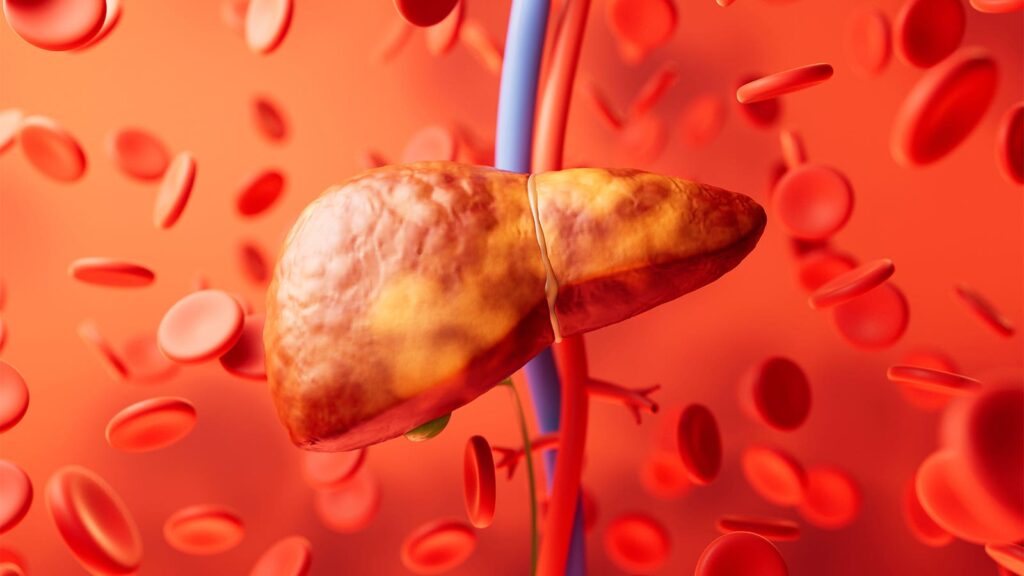The new nomenclature for classifying steatotic liver disease (SLD) can help clinicians determine distinct prognoses, with the integration of alcohol intake as an aid in risk stratification, according to an analysis of a prospective cohort study from Denmark.
At a single center among 446 patients with a history of excessive alcohol intake, those with SLD had a significantly higher risk of hepatic decompensation and overall mortality than those without SLD, independent of age, sex, and liver stiffness, reported Mary E. Rinella, MD, of the Pritzker School of Medicine at the University of Chicago, and colleagues.
Notably, the risk of hepatic decompensation increased in a stepwise manner from metabolic dysfunction-associated steatotic liver disease (MASLD; HR 4.73, 95% CI 1.03-21.6), through metabolic dysfunction and alcohol-related steatotic liver disease (MetALD; HR 7.69, 95% CI 1.66-35.6), to alcohol-related liver disease (ALD; HR 10.2, 95% CI 2.24-46.4), they noted in the Lancet Gastroenterology & Hepatology.
The same was true for overall mortality, increasing from MASLD (HR 2.30, 95% CI 1.08-4.90), through MetALD (HR 2.94, 95% CI 1.31-6.58), to ALD (HR 3.57, 95% CI 1.64-7.80).
“Importantly, we found that the subclasses had different prognoses, underlining the significance of considering steatotic liver disease … as a spectrum rather than distinct conditions (NAFLD [nonalcoholic fatty liver disease] or ALD),” the authors wrote, adding that the criteria for SLD are easy to apply in clinical studies.
“Further specification on how historical alcohol intake should be incorporated into the nomenclature is needed, because this subclassification has important implications for clinical studies and management,” they concluded. “Criteria for moving between subclasses also need to be defined.”
In an accompanying comment, Fredrik Åberg, MD, PhD, of the University of Helsinki in Finland, noted that the study “provides critical insights into the interplay between dysmetabolism and past and present alcohol consumption in steatotic liver disease.”
“This subclassification acknowledges the frequent coexistence and synergism of metabolic risk and alcohol use, viewing them more as a spectrum than mutually exclusive conditions,” he wrote. “Given its consensus-based origin, the steatotic liver disease subclassification requires validation for clinical relevance and applicability.”
Åberg also pointed out that the thresholds for alcohol consumption within the subclasses of SLD are still arbitrary, and patients with SLD should be counseled that abstinence from alcohol is the “best bet for a brighter forecast.”
For this analysis, Rinella and team enrolled 446 patients (median age 56, 75% men) from Odense University Hospital with a history of current or previous excessive alcohol use (>24 g/day for women and>36 g/day for men) of at least a year’s duration who had no hepatic decompensation from April 2013 to September 2018. They were classified as having MASLD, MetALD, or ALD based on metabolic comorbidity and self-reported average alcohol intake in the 3 months leading up to inclusion and were followed until Sept. 15, 2022.
Of these patients, 13% had cirrhosis, and 98% had at least one cardiometabolic risk factor, such as a body mass index of 25 or higher, type 2 diabetes, blood pressure of 130/85 mm Hg or higher, plasma triglycerides of 150 mg/dL or higher, or plasma high-density lipoprotein cholesterol of 40 mg/dL or less for women or 50 mg/dL or less for men, or treatment for any of these conditions.
Of the cohort, 72% met SLD criteria, and 28% did not, meaning they had no evident liver steatosis and no significant fibrosis (≥F2). Of the patients with SLD, only 2% were identified as having ALD due to the absence of cardiometabolic risk factors. The other 98% of patients had at least one cardiometabolic risk factor. Of these patients, 49% had MASLD, 24% had MetALD, and 27% had ALD.
During a median follow-up of 70 months, 15% of patients decompensated and 22% died, with 48 dying after liver decompensation and one due to cholangiocarcinoma.
The risk of all-cause mortality was lower in groups who self-reported abstinence when they enrolled in the study: less than 1 year of alcohol abstinence (HR 0.64, 95% CI 0.30-1.36), 1 to 5 years (HR 0.97, 95% CI 0.33-2.82), and more than 5 years (HR 0.37, 95% CI 0.08-1.74), though the authors noted the wide confidence intervals with these estimates.
Rinella and team acknowledged that the classification of many patients as having MASLD, despite documented excessive alcohol intake during the follow-up period, “probably does not accurately represent the prognosis of so-called pure MASLD without a history of excessive alcohol intake,” which was a limitation to the study.
Disclosures
This study was funded by the EU Horizon 2020 Research and Innovation Program.
Rinella reported scientific consulting for Boehringer Ingelheim, Intercept Pharmaceuticals, Madrigal, NGM Biopharmaceuticals, Novo Nordisk, GlaxoSmithKline, Sonic Incytes, HistoIndex, Takeda, and CytoDyn, and has received support for travel to symposia from GlaxoSmithKline and Novo Nordisk.
Co-authors also reported multiple relationships with industry.
Åberg reported no competing interests.
Primary Source
The Lancet Gastroenterology & Hepatology
Source Reference: Israelsen M, et al “Validation of the new nomenclature of steatotic liver disease in patients with a history of excessive alcohol intake: an analysis of data from a prospective cohort study” Lancet Gastroenterol Hepatol 2024; DOI: 10.1016/S2468-1253(23)00443-0.
Secondary Source
The Lancet Gastroenterology & Hepatology
Source Reference: Åberg F “The role of past and present alcohol use in steatotic liver disease” Lancet Gastroenterol Hepatol 2024; DOI: 10.1016/S2468-1253(23)00450-8.
>>> Read full article>>>
Copyright for syndicated content belongs to the linked Source : MedPageToday – https://www.medpagetoday.com/gastroenterology/generalhepatology/108305
